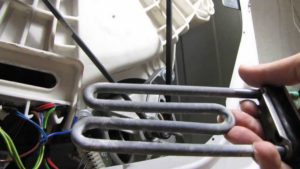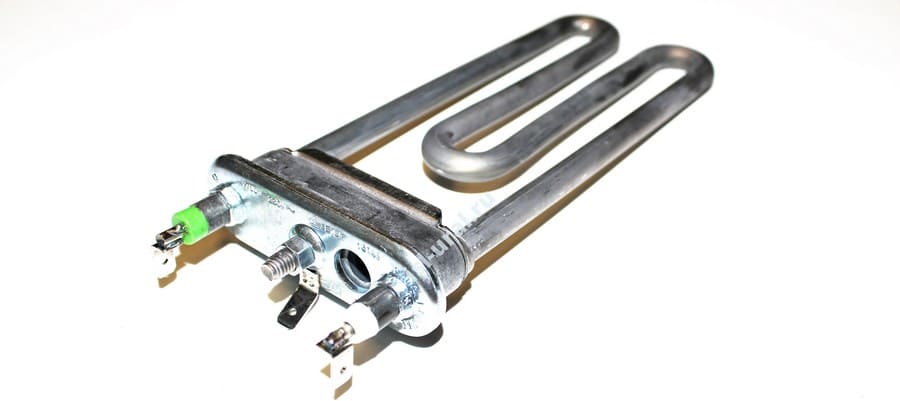 Samsung washing machines are modern household appliances that operate for a long time without any problems. Unfortunately, it is almost impossible to manufacture a device in which there is completely no friction between the mating and rotating parts, and in which there is no destruction of the metal from exposure to an aggressive environment. Therefore, sooner or later, parts of the washing machine such as heating elements, belts and the motor will need to be replaced. This article will describe in detail how to replace the heating element in a Samsung washing machine. To perform this operation, no special education is required, and in order to remove the old element and install a new one, it is enough to have a screwdriver and pliers.
Samsung washing machines are modern household appliances that operate for a long time without any problems. Unfortunately, it is almost impossible to manufacture a device in which there is completely no friction between the mating and rotating parts, and in which there is no destruction of the metal from exposure to an aggressive environment. Therefore, sooner or later, parts of the washing machine such as heating elements, belts and the motor will need to be replaced. This article will describe in detail how to replace the heating element in a Samsung washing machine. To perform this operation, no special education is required, and in order to remove the old element and install a new one, it is enough to have a screwdriver and pliers.
How to determine a heating element malfunction
It’s easy to figure out how to remove the heating element from a Samsung washing machine on your own, but you should understand that such an operation takes a lot of time, in addition, you will need to buy a new heating element to replace it. In order to avoid mistakes at the stage of making a correct “diagnosis”, you need to know about the main signs of such a breakdown and the reasons for its occurrence. You can determine the situation when it is necessary to replace the heating element of a Samsung washing machine by the following operating features of the device:
- The laundry is not washed well.
- During the washing process, the sunroof glass remains cold.
- Power consumption during operation of the Samsung washing machine has decreased dramatically.
The last option for determining the malfunction is quite complicated, but if other consumers of electricity are disconnected during operation of the washing machine, then it is enough to record the meter readings before the start of washing and at the end of the full cycle of the device. Depending on the brand of the washing machine, power consumption can vary significantly. The average value of this indicator is 1 kW per wash. Operation of the washing machine on a full wash cycle without heating the water can change the meter reading by only 200 - 300 watts, therefore, with such a small power consumption, we can safely say that the heating element in the machine was not turned on.
Poorly washed laundry does not always indicate the lack of water heating during washing, because the market for counterfeit washing powder products is quite large. In the presence of such a diagnostic sign, it is recommended to additionally measure the power consumption and check the door cover for heating, but not earlier than 20 minutes after the start of washing. At the end of washing, it is also impossible to determine the malfunction using this method, because the rinsing of the laundry is done without heating the water.
The main reason for the failure of the heating element is the formation of scale. With significant limescale, the heating element overheats, which eventually leads to the burnout of the spiral located inside the tubular element. Sometimes the lack of heating of the water can be caused by insufficient contact between the terminals of that part of the wiring through which the electric current is supplied to the heating element.Also, the heater may not turn on due to a malfunction of the temperature sensor. In any case, the true reason for the failure of the heating element will be found only after the household appliance is disassembled and the heating element is removed from its installation location. How to remove the heating element from a Samsung washing machine will be discussed below.
Removing the heating element from a Samsung washing machine

The tubular electric heating element can be located either in the front of the washing machine or directly behind the rear wall of the device. If its exact location is unknown, then it is recommended to begin disassembling the household appliance by removing the back cover. This operation will not take much time, because all you need to do is unscrew 4 screws. Before you begin the operation, be sure to turn off the power to the device and disconnect the water intake hose from the water supply system.
After removing the cover, access to the heating element will be open, which can be determined by the presence of wires connected to the product using threaded connections.
If, after removing the cover, the heating element is not detected, then a more labor-intensive operation will be required to remove the front panel of the device. In order to get to the heating element located in the front of the Samsung washing machine, you need to:
- Remove the top cover. To do this, unscrew 2 screws, move the cover back a little and remove this part of the device body with a slight upward movement.
- Remove the powder dispenser hopper, behind which there are 2 screws holding the front cover. Using a screwdriver, the holding hardware is removed.
- Unfasten the lower false panel.
- Unscrew the bottom screws holding the front panel.
- Lift up the control panel, behind which there are screws. These hardware also need to be unscrewed.
- Remove the hatch cuff. To do this, you need to pick up this part near the door buttonhole with a slotted screwdriver.
- Unscrew the screws holding the door lock.
- Remove the front panel.
In the process of performing the above steps, you must be careful not to snag or break the thin wires that go from the control unit to the various electrical elements of the Samsung washing machine.
Regardless of the location of the heating element, after access to it is opened, you can begin to check the heater for functionality.
Checking the heating element
You can start checking the heating element even before this part is completely disconnected from the wires and removed from the tank of the Samsung washing mashine. To quickly assess the performance of the heater, you can use any device for measuring resistance. The most suitable and inexpensive device that allows you to “ring” this part is a multimeter.
At the moment when the heater burns out, the spiral breaks inside the tubular element, so this malfunction can be determined if the measuring device shows the presence of zero resistance between the terminals. In order not to receive incorrect information, it is necessary to switch the device to the mode of changing the resistance, connect both probes to check its functionality and then apply them to the contacts of the electrical element. If the device does not respond to the touch of the probes to the “legs” of this part, then you can proceed to the next stage of repairing the Samsung washing machine.Otherwise, you will need to check the temperature sensor or control unit of the household appliance.
Replacing the heating element

If, as a result of measuring the resistance, a malfunction of the heating element was identified, then it must be replaced with a heating element of the same power and size. Replacing the heating element in a Samsung washing machine is performed in the following sequence:
- After unscrewing the small nuts on the contacts of the heating element, you need to remove the wires connected to it, and also remove the terminals from the temperature sensor.
- Use pliers or a socket wrench to loosen the central nut, which then needs to be pressed with some elongated object.
- Using a slotted screwdriver, pry the heating element around the entire perimeter and carefully remove it from the tank.
- A new heating element is being installed.
Before installing a new heating element, it must also be checked with a multimeter. In order to simplify installation, as well as to ensure greater tightness, it is recommended to lubricate the rubber gasket of the heating element with engine oil. All operations are performed in the reverse order of removal. In this case, you should ensure the highest quality connection of the wires with the heating element. Some models may be equipped with a heating element, the power of which can reach 2 kW, so insufficient contact of the wires supplied to the part can lead to their burnout.
Conclusion
How to change the heating element is described in detail in this article, but when performing this work, you should be careful and perform all of the above actions only on a household device that is disconnected from electricity.
Given the fact that there are other critical electronic and mechanical parts inside the device, in order to remove a heating element that is faulty and install a new heater, maximum care must be taken, especially when handling heavy tools.









